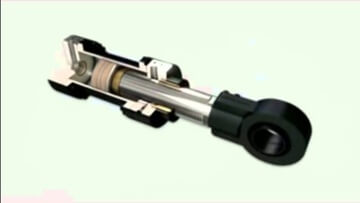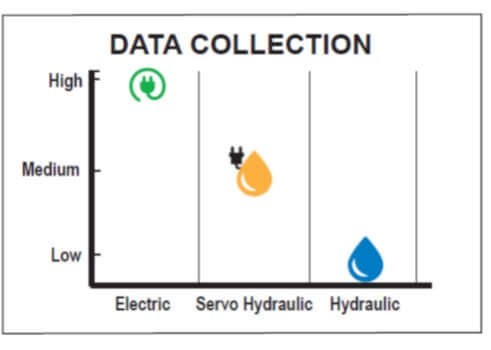Hydraulic linear actuator advantages and disadvantages
By Tolomatic on May 17, 2016
 Hydraulic cylinders are popular automation components in many industries. Like other types of linear actuator (pneumatic and electric), they are used to move loads in a straight line. A hydraulic actuator uses the energy in a pressurized liquid, usually oil, to achieve this linear motion, as opposed to compressed air (pneumatics) or electricity.
Hydraulic cylinders are popular automation components in many industries. Like other types of linear actuator (pneumatic and electric), they are used to move loads in a straight line. A hydraulic actuator uses the energy in a pressurized liquid, usually oil, to achieve this linear motion, as opposed to compressed air (pneumatics) or electricity.
Standard hydraulic actuators perform well in applications that require basic, end-to-end motion. However, as motion profiles get more complex, standard hydraulics have difficulties. A complex motion profile usually needs a costly servo-hydraulic actuation system or an electric linear actuator. In fact, many engineers are turning to electric linear actuators since new models can deliver the high force once thought possible only with hydraulics.
Our newest white paper compares hydraulic and electric linear actuator technologies. Download your copy here.
There are pluses and minuses to using hydraulic actuators. Let’s take a look at them.
Hydraulic actuator advantages
Hydraulic linear actuators are popular for good reason.
- High force capabilities
The ability of hydraulics to deliver high force is a leading reason for the popularity of this technology. High pressures allow smaller cylinders to reach very large forces. For example, 3-inch and 5-inch bore cylinders at 2200 psi can achieve approximately 15,000 lbf (66,723.3 kN) and 43,000 lbf (191,273.5 kN), respectively.
- Simple design
Hydraulic technology is well-understood, and cylinder design is straight-forward. Many engineers are quite comfortable using hydraulics.
- Rugged construction

Hydraulic actuators have a reputation for being tough enough to withstand harsh conditions. They can be durable and reliable when deployed in the right applications. Their robust design means they can handle shock loads.
- Affordable
The initial purchase price of hydraulic cylinders is usually low.
Hydraulic actuator disadvantages
- Limited motion control capabilities
When multiple stops and changes in velocity are part of the motion profile, hydraulic cylinders have problems. Also, position, speed and force consistency are subject to worn seals, leaks and pressure changes from the pump.
- Inflexibility
Basic hydraulic actuators are not programmable. Changes in force, velocity and other variables are made through time-consuming manual adjustments which may be imprecise. Servo-hydraulic actuation systems are programmable, but they have more components that add complexity, space, and cost.
- Inadequate data collection capabilities

Data collection and reporting are required in many manufacturing environments as part of continuous improvement processes. Hydraulic cylinders need expensive, complex servo-hydraulic systems with additional sensors to track and monitor what’s happening at the work point.
- High maintenance
Hydraulic cylinders are rugged devices, but they require frequent maintenance and attention to perform well. Maintaining the integrity of the rod and piston seals is key because these are the main elements that contain pressure. Changing oil filters and oil must be done periodically since contaminated or degraded oil hurts system operation.
- Low operating efficiency
Hydraulic systems typically operate in the 40-55% efficiency range. While this is better than that of pneumatic systems (10-20%), it is much lower than that of electric systems (75-80%). Additionally, with hydraulics the power unit keeps the hydraulic system pressurized when the system is turned on, resulting in inefficient use of power.
- Large system footprint
A hydraulic actuator system's components take up valuable space. Even though hydraulic cylinders offer a compact footprint at the work point, the hydraulic power unit (HPU) that regulates flow and pressure to cylinders requires a large amount of floor space. Systems include the cylinder, the power unit to provide oil pressure, control and accessory valves, filters, hoses, fittings, and additional components.
- Temperature sensitivity
Both hot and cold temperatures affect the performance of hydraulic cylinders. Heat can destroy seals resulting in loss of pressure. Cold temperatures will thicken the system’s oil and slow response.
Study your application and all its requirements carefully before you settle on an actuation technology. If you need a programmable, efficient, low-maintenance actuator that can handle a complex motion profile, consider an electric linear actuator.
A later edition of this blog will compare hydraulic and electric actuation. Plus, our white paper gives you an in-depth comparison.
Learn more
Download our white paper that compares hydraulic and electric linear actuator technologies.

 Ask an Engineer
Ask an Engineer